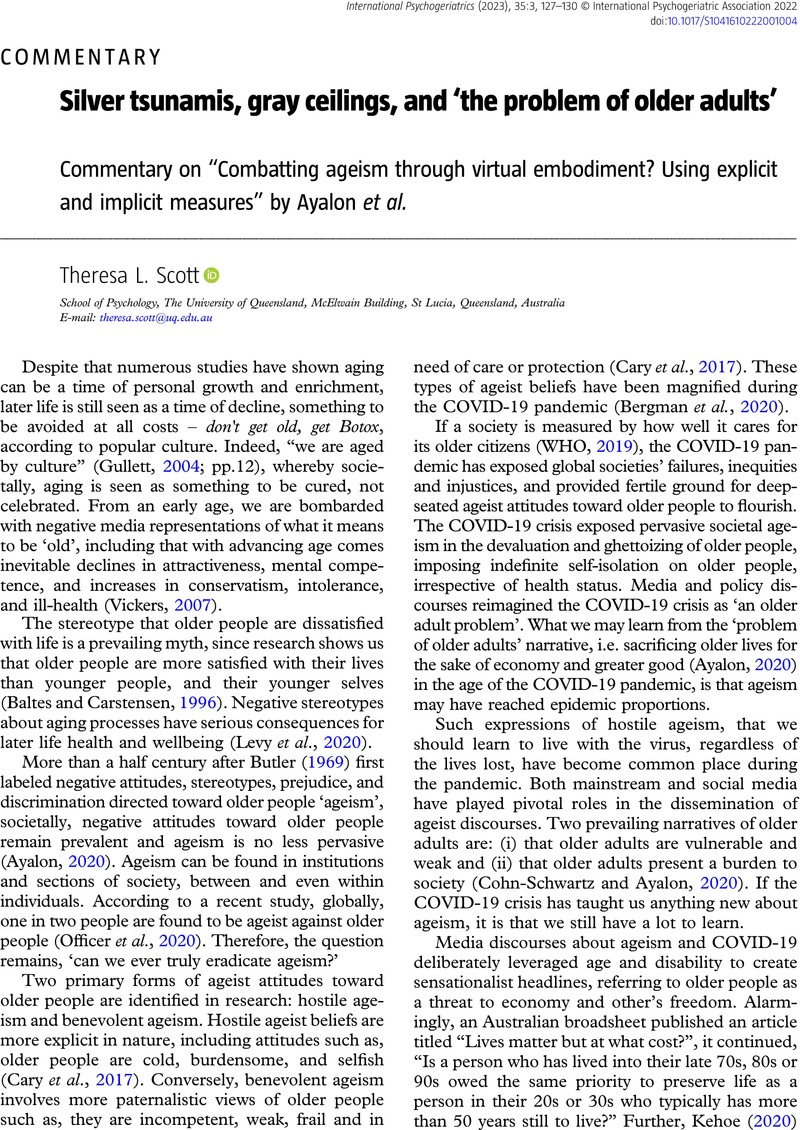No CrossRef data available.
Article contents
Silver tsunamis, gray ceilings, and ‘the problem of older adults’
Commentary on “Combatting ageism through virtual embodiment? Using explicit and implicit measures” by Ayalon et al.
Published online by Cambridge University Press: 01 December 2022
Abstract
An abstract is not available for this content so a preview has been provided. Please use the Get access link above for information on how to access this content.

- Type
- Commentary
- Information
- Copyright
- © International Psychogeriatric Association 2022
References
Ayalon, L. (2020). There is nothing new under the sun: ageism and intergenerational tension in the age of the COVID-19 outbreak. International Psychogeriatrics, 32, 1221–1224. DOI 10.1017/S1041610220000575.CrossRefGoogle ScholarPubMed
Ayalon, L., Dayan, E. and Freedman, S. (2022). Combatting ageism through virtual embodiment? Using explicit and implicit measures. International Psychogeriatrics, 35, 157–163.Google Scholar
Baltes, M. M. and Carstensen, L. L. (1996). The process of successful ageing. Ageing & Society, 16, 397–422. DOI 10.1017/S0144686X00003603.CrossRefGoogle Scholar
Bergman, Y., Cohen-Fridel, S., Shrira, A., Bodner, E. and Palgi, Y. (2020). COVID-19 health worries and anxiety symptoms among older adults: the moderating role of ageism. International Psychogeriatrics, 32, 1371–1375. DOI 10.1017/S1041610220001258.CrossRefGoogle ScholarPubMed
Burnes, D., Sheppard, C., Henderson, C. R. Jr, Wassel, M., Cope, R., Barber, C. and Pillemer, K. (2019). Interventions to reduce ageism against older adults: a systematic review and meta-analysis. American Journal of Public Health, 109, e1–e9.CrossRefGoogle ScholarPubMed
Butler, R. N. (1969). Ageism: another form of bigotry. The Gerontologist, 9, 243–246. DOI 10.1093/geront/9.4_Part_1.243.CrossRefGoogle ScholarPubMed
Cary, L. A., Chasteen, A. L. and Remedios, J. (2017). The ambivalent ageism scale: developing and validating a scale to measure benevolent and hostile ageism. The Gerontologist, 57, gnw118. DOI 10.1093/geront/gnw118.Google ScholarPubMed
Cohn-Schwartz, E. and Ayalon, L. (2020). Societal views of older adults as vulnerable and a burden to society during the COVID-19 outbreak: results from an israeli nationally representative sample. The Journals of Gerontology Series, B, 1–5. DOI 10.1093/geronb/gbaa150.Google Scholar
Kehoe, J. (2020). Lives matter but at what cost? Australian Financial Review. https://www.afr.com/politics/federal/lives-matter-but-at-what-cost-20200407-p54hox
Google Scholar
Kossen, C. and Pedersen, C. (2008). Older workers in Australia: the myths, the realities and the battle over workforce flexibility. Journal of Management & Organization, 14, 73–84.CrossRefGoogle Scholar
Levy, B. (2009). Stereotype embodiment: a psychosocial approach to aging. Current Directions in Psychological Science, 18, 332–336. DOI 10.1111/j.1467-8721.2009.01662.x.CrossRefGoogle ScholarPubMed
Levy, B. R., Chung, P. H., Bedford, T. and Navrazhina, K. (2014). Facebook as a site for negative age stereotypes. The Gerontologist, 54, 172–176. DOI 10.1093/geront/gns194.CrossRefGoogle ScholarPubMed
Levy, B. R., Slade, M. D., Chang, E. S., Kannoth, S. and Wang, S. Y. (2020). Ageism amplifies cost and prevalence of health conditions. The Gerontologist, 60, 174–181. DOI 10.1093/geront/gny131.CrossRefGoogle ScholarPubMed
Meissner, F., Grigutsch, L. A., Koranyi, N., Müller, F. and Rothermund, K. (2019). Predicting behavior with implicit measures: disillusioning findings, reasonable explanations, and sophisticated solutions. Frontiers in Psychology, 10. DOI
10.3389/fpsyg.2019.02483.Google Scholar
Neal, I., du Toit, S. H. and Lovarini, M. (2020). The use of technology to promote meaningful engagement for adults with dementia in residential aged care: a scoping review. International Psychogeriatrics, 32, 913–935. DOI 10.1017/S1041610219001388.CrossRefGoogle Scholar
Officer, A., Thiyagarajan, J. A., Schneiders, M. L., Nash, P. and de la Fuente-Núñez, V. (2020).
Ageism, healthy life expectancy and population ageing: how are they related? International Journal of Environmental Research and Public Health, 17, 3159. DOI 10.3390/ijerph17093159.CrossRefGoogle ScholarPubMed
Skurla, M. D. et al. (2022). Virtual reality and mental health in older adults: a systematic review. International Psychogeriatrics, 34, 143–155. DOI 10.1017/S104161022100017X.CrossRefGoogle ScholarPubMed
Vickers, K. (2007). Aging and the media: yesterday, today, and tomorrow. Californian Journal of Health Promotion, 5, 100–105.CrossRefGoogle Scholar
World Health Organization. (2019). A society is measured by how it cares for its elderly citizens. Available at: https://www.who.int/news-room/feature-stories/detail/a-society-is-measured-by-how-it-cares-for-its-elderly-citizens.Google Scholar




